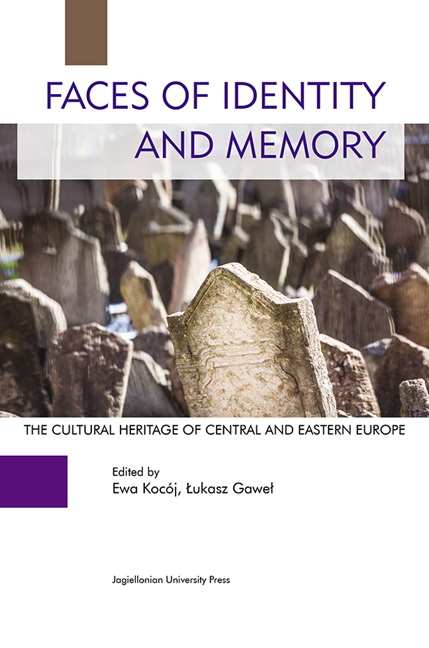 Faces of Identity and Memory
Faces of Identity and Memory Book contents
- Frontmatter
- Contents
- Introduction
- Memory and Identity. Monuments of Romanian Tangible Culture Inscribed on the UNESCO World Heritage List (a Short Presentation)
- Inventorisation and Recording of Sacral Art Objects in Lithuania in 1995–2005
- National lieux de mémoire and the European Heritage Label. Some Reflections on the Case of the Gdańsk Shipyard
- Porrajmos. Constructing Gypsy Holocaust Memory in the Recent Cinema
- The Vacuum and the Imagination of Space. The Cultural Role of the Żyznowski Publishing House
- Cultural Animation as the Art of Remembering. The Activities of the “Borderland of Arts, Cultures and Nations” Centre in Sejny
- ‘The Painted Village’ – Zalipie as an Expression of Ethnographic Tourism in the Powiśle Dąbrowskie Region of Poland
- 20th Century Theatrical Heritage: The Escape from Illusion
- Protection of Cultural Heritage. The Case of Krakow
- Managing an Artist's Legacy on the Example of Foundation for Support of Modjeska's Life and Art Research in Kraków
- Culinary Heritage as Used in the Present. Selected Elements of the Culinary Heritage Management in Contemporary Poland
Memory and Identity. Monuments of Romanian Tangible Culture Inscribed on the UNESCO World Heritage List (a Short Presentation)
Published online by Cambridge University Press: 10 January 2018
- Frontmatter
- Contents
- Introduction
- Memory and Identity. Monuments of Romanian Tangible Culture Inscribed on the UNESCO World Heritage List (a Short Presentation)
- Inventorisation and Recording of Sacral Art Objects in Lithuania in 1995–2005
- National lieux de mémoire and the European Heritage Label. Some Reflections on the Case of the Gdańsk Shipyard
- Porrajmos. Constructing Gypsy Holocaust Memory in the Recent Cinema
- The Vacuum and the Imagination of Space. The Cultural Role of the Żyznowski Publishing House
- Cultural Animation as the Art of Remembering. The Activities of the “Borderland of Arts, Cultures and Nations” Centre in Sejny
- ‘The Painted Village’ – Zalipie as an Expression of Ethnographic Tourism in the Powiśle Dąbrowskie Region of Poland
- 20th Century Theatrical Heritage: The Escape from Illusion
- Protection of Cultural Heritage. The Case of Krakow
- Managing an Artist's Legacy on the Example of Foundation for Support of Modjeska's Life and Art Research in Kraków
- Culinary Heritage as Used in the Present. Selected Elements of the Culinary Heritage Management in Contemporary Poland
Summary
Abstract: in recent years the romanian cultural heritage has been gaining more and more interest from european scholars. it is understandable, since the turn of the 20th and 21th century is regarded as the moment of the explosion of interest in the subject of heritage and collective memory. romania, which in the time of communist regime was a “stronghold” on the border of the east and west, can still boast unknown and unresearched monuments, which provide a lot of new information on byzantine and post-byzantine culture, as well as on the cultures of ethnic and religious minorities living in this country.
This article presents the characteristics of cultural heritage management in Romania, as well as the most important institutions dealing with this. Tangible cultural heritage listed as UNESCO World Heritage Sites are presented, e.g. the painted orthodox churches and monasteries of Bukovina, the wooden churches of Maramureș, the Dacian Fortresses of the Orăștie Mountains, and the fortified churches in Transylvania. The discourse around these monuments in the Romanian culture is also briefly commented on. It revolves around the ancient settlement myth referring to the Dacian heritage, the orthodox faith understood as fidelity to original Christianity and, gradually, the multicultural heritage of other ethnicities so strongly inhabiting the Romanian territory. It shows that Romania, just like other European countries, has the need to present its history through tangible heritage and emphasizing the Dacian-Roman and Orthodox identity, as well as the need to create new narrative and new post-communist countenance, with a clearly emphasized aspect of a multicultural country inhabited by various ethnicities and religions.
Key words: tangible heritage, UNESCO, Romania, Orthodox churches, Dacian fortresses, historic cities, defensive fortresses, identity, collective memory Cultural heritage of Romania is becoming more and more interesting for the researchers of the topic in Europe.1 And it is not that peculiar. On the one hand, the turn of the 20th and 21st centuries has been considered an explosion of interest in the area of heritage and collective memory, and, on the other – Romania – a country, which embodied a “guarded fortress” during the communist regime, situated on the border of East and West, can still offer little known and researched monuments providing plenty of knowledge on the Byzantine and post-Byzantine culture as well as on cultures of ethnic and religious minorities dwelling there.
- Type
- Chapter
- Information
- Faces of Identity and MemoryThe Cultural Heritage of Central and Eastern Europe (Managing and Case Studies), pp. 11 - 34Publisher: Jagiellonian University PressPrint publication year: 2015


